Stay Mobile
My absolute number one tip for winter carp fishing is to stay mobile. Until you are completely confident that you know the stock are holed up and exactly where they have chosen to spend the bulk of their time then you need to keep moving. With a smaller stock of carp that are of a good size there’s a good chance of finding all of those carp in a group together so why spend your entire session in one place. If the lake’s very highly stocked, then they’ll often be in smaller groups all over the lake so moving and exploiting this to its full potential can see you have a very good days angling.
Chances are that if you keep moving to the likely areas around your lake you will eventually find them, and even if they do spook they’ll usually not go far and return quickly as that’s where they want to be. Dropping a rod in a likely area for half an hour is usually plenty of time if that’s where they are, and if not, then you can move to the next spot quickly and easily if you’re prepared and ready.
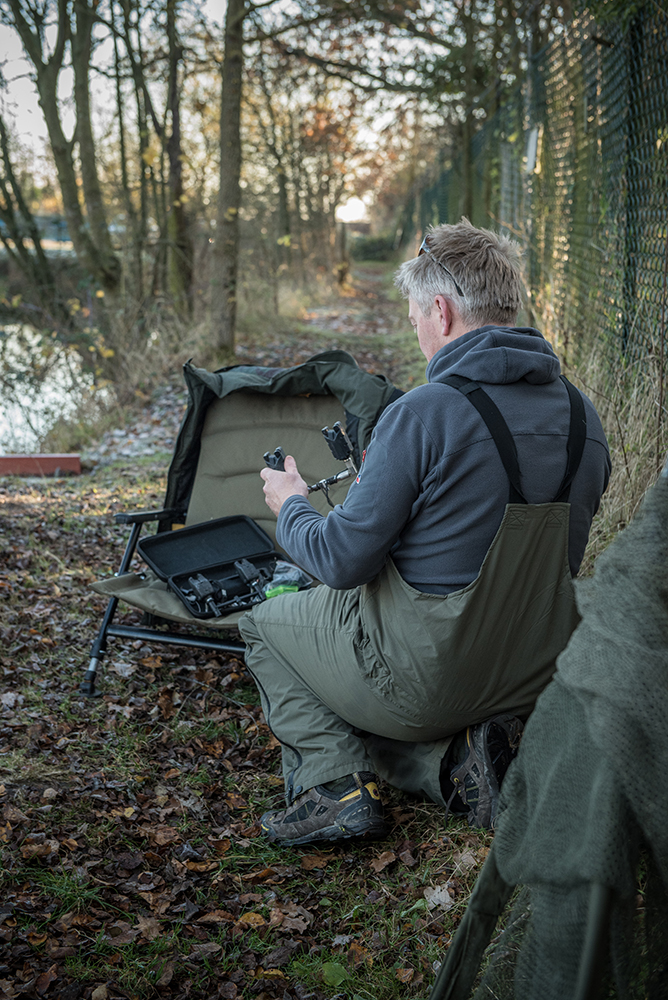
High Stock Levels
Dependant on the lake you choose, although a shallow lake is often favourable in winter, it’s important for me to choose a lake that has a good stock of carp. I don’t want to sit for days on end after one carp, I’ve been there and done it for countless years and I no longer see the benefits of doing so. These days’ short sessions are favoured, morning or evening, so it’s imperative that I can realistically pack up having caught a couple of fish.
A shallow lake, or one a few acres in size offers much less water for the fish to hide in, and if it’s stocked well then you can never be too far away from a bite if you reason that a well-stocked lake will generally have plenty of groups of fish. My sole aim of winter session is to catch a carp, so why make things difficult for myself to get the fix I crave. Snaggy margins and deeper holes give the lakes stock something to hold in, and a high stock lake works hand in hand with the first tip of staying mobile.
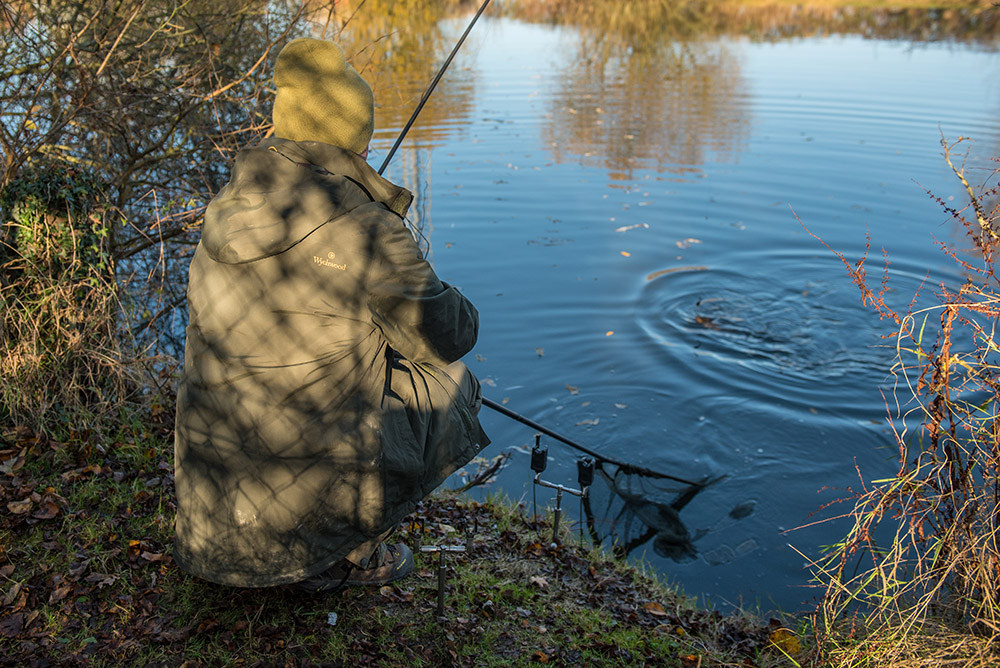
Travel Light
Are you noticing a theme here? Travelling light again means you can chase the fish around the lake, makes it much easier to stay mobile and help you get those winter bites. I always carry coffee kit, a chair and a quantity of bait still but equally I can carry everything I need for a few hours fishing short sessions on a cold winters day. There’s no need to make yourself uncomfortable but a good rucksack will help you carry everything you need on your back and stop you being lazy, plus, walking your gear round the lake keeps you warm too. If you’re fishing with mates then share the load, one take the water and the other the brew kit, but to me the kettle is an essential in winter, no matter how light I ned to travel.
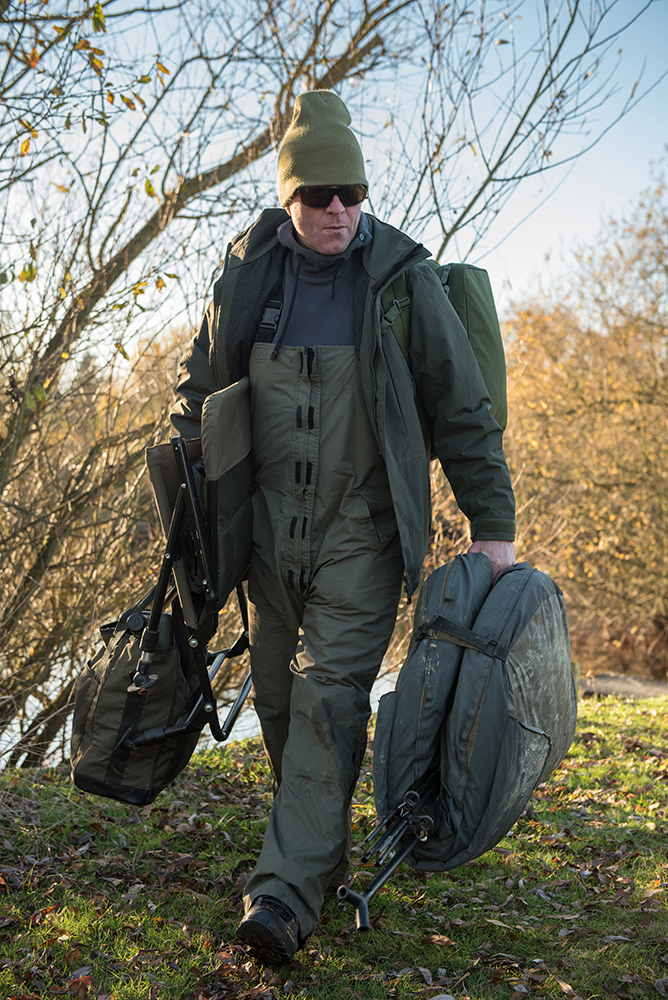
Boots Will Do
It’s been harked on about for years about layering, outer layers, good waterproofs, thermals and so on, and yes they are massively vital in the colder months to stop you getting ill and ensuring you enjoy your time on the bank, but one big tip from me is to ditch those big winter boots on short sessions. If you’re going for the day, or even half a day, then a mobile approach in those big, fluff-lined all-in-one bulky welly’s may be warm if you’re stood still, but as soon as you start walking the lake, moving between swims and generally just angling as opposed to sitting on your backside, then you’ll not only find them difficult to walk in but your feet will sweat and become cold anyway. My advice is to get a regular pair of walking shoes or boots depending on the banks of the lake and wear a good pair of socks, you shouldn’t be stood still for long enough to get cold anyway if you’re staying mobile.
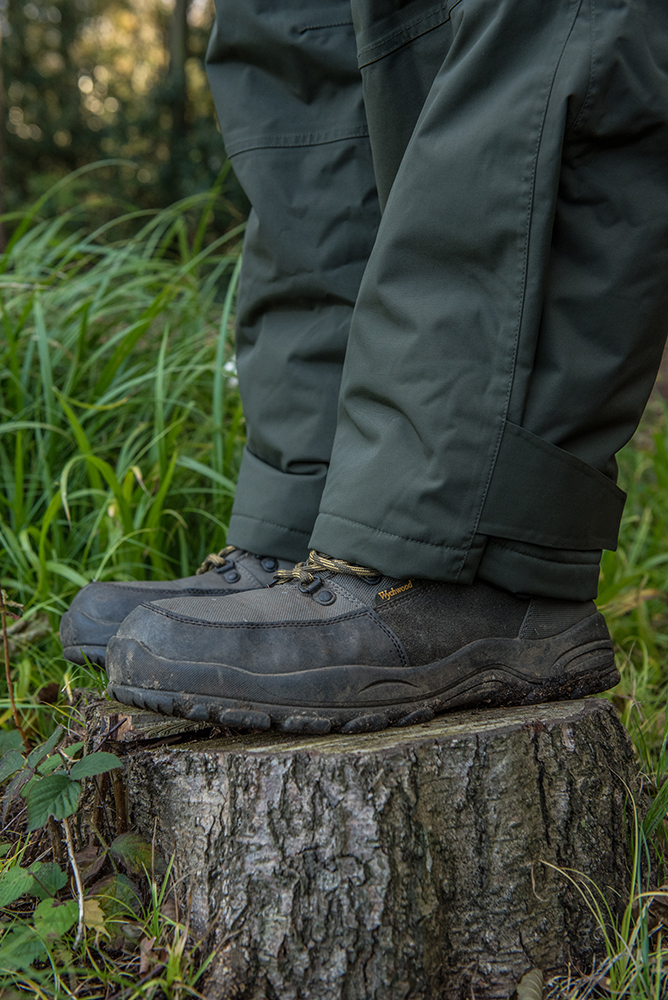
Channel Those OCD’s
When you’re winter fishing and you plan to stay mobile and angle properly, then being organised may sound silly but it really helps you fish more effectively. I’m the world’s worst for organisation, but once my rods are out the first thing I’ll do is re-pack my rucksack so the terminal tackle, bait and all the other odds and ends are ready to move to the next swim. I might not move for an hour and the brew kit will stay out to keep me warm, but if everything else is ready to go then it makes the next move much easier to consider.
Keep your huge array of hook baits at home and only take the few tubs you’re likely to need, equally, trim your tackle bag down, are you really going to surface fish, there’s no harm in leaving a pouch in the car if the rare opportunity does present itself.
Light Baiting
On short sessions, which is the majority of my winter fishing, do not bait heavily. I don’t take masses of bait, don’t confuse yourself just take what you know works. I can make up all the fancy stick mixes like I used to but most of the time on these winter waters are fairly inactive so a simple balanced snowman with small boilies and a small handful of chopped baits with some pellet is plenty. If they’re there, they’ll be enticed to feed pretty quickly, so there’s no need to over-complicate things and confuse yourself. I do like to use liquids more frequently when I’m baiting lightly, a smaller quantity of bait that is highly attractive will bring faster bites than heavy baiting with boilie straight from the bag.
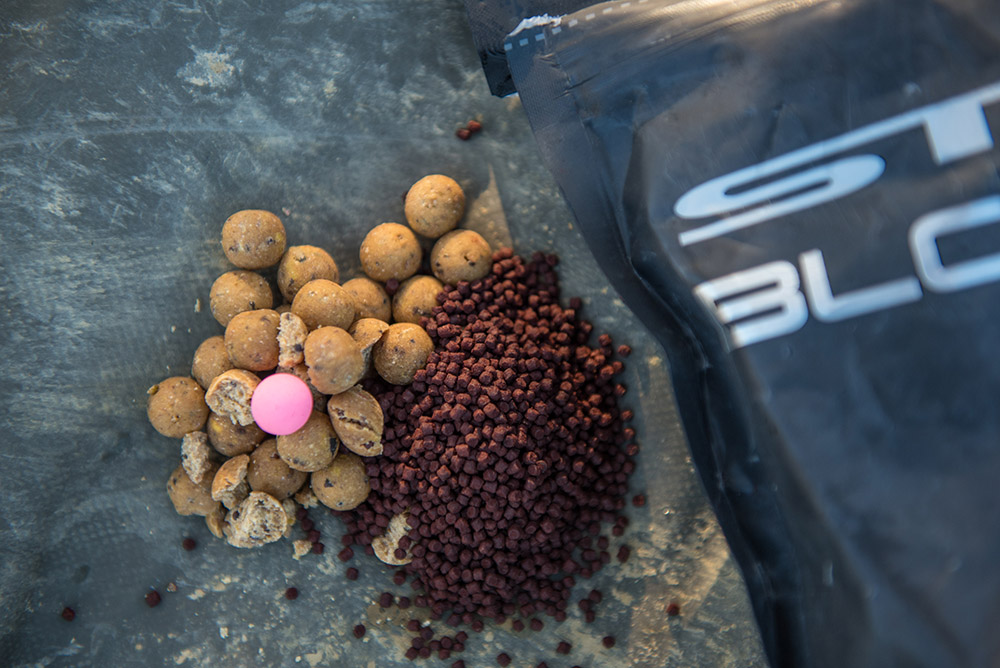
A Scalding Review
Pellet is a great bait to instigate fish to feed, always has been and always will be. In the colder water throughout the winter oils and bait breaks down much more slowly, so I will usually scald my pellet mix to begin the breakdown process and stop it from solidifying on the lakebed. The hot water will instantly start breaking the structure of the pellet and will be incredibly attractive for any fish in the swim. A big handful of pellet with a few broken boilies in there with a kettle of boiling water over the top and left to soak in is a deadly tactic that I can’t recommend highly enough, it’s just not done often enough these days.
The consistency will be quite mushy but as the water soaks in you will get to a stage where you can ball it up and chuck it over your rigs when it’s still warm, the carp love it and it’s so easy to make up. You can add liquids and bait boosters too if you really want to get them going.
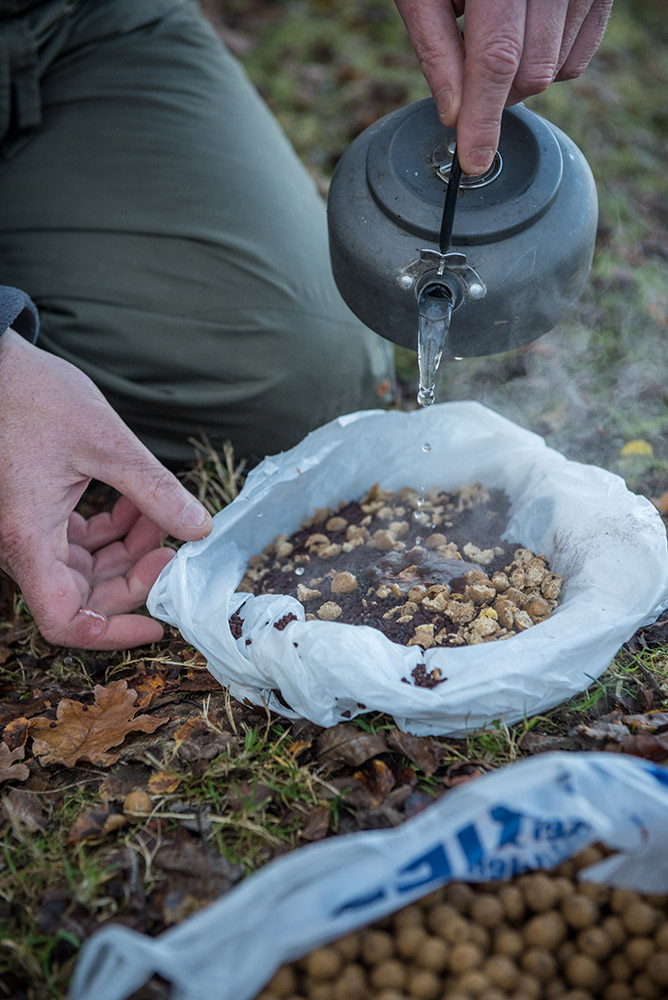
Don’t over-complicate It
Most lakes will see the water clarity improve drastically in winter as any natural fauna dies off and generally the fish stir the bottom up less too. With this comes their increased visibility so I like to fish a three-foot length of fluorocarbon instead of any leadcore or tubing. Tied on to my mainline the stop knot will house a sliding tube just above which I can mould putty around and even when I’m fishing in the margins below my rod tip I can ensure my gear is pinned to the deck, and very hard for the fish to spot.
To go with this a simple braided hair rig and snowman presentation is more than enough to convert takes to landed fish so there’s no need to over-complicate it, just get out there and keep moving until you find the fish, that’s far more important than what fandango rig you’re using. A pair of Extricator rods with small reels and small leads lends itself perfectly to this quick-hit style of fishing I prefer in winter.
Pop-ups
As the weather turns early in winter the leaves that have dropped in the Autumn will be collecting in the lake and making it much harder to present a hook bait, which is why I always advise you to at least take pop-ups with you, if not utilise them regardless. A critically balanced snowman or even a pop-up a few inches off the deck will ensure your hook bait is presented and your rig is fishing effectively if you do happen to drop onto some softer ground where the lake bed is littered with detritus.
This comes into its own when you can’t get round and drop your rod by hand as it becomes much harder to get an accurate interpretation of the lake bed as you’ll simply spook the swim by casting too much. I’ll often fish these as singles too as it’s a good gauge to try and find the fish, there’s very little disturbance and the fish have started to slow down their feeding, so if you can entice one to pick one bait up, it may as well be the one attached to your hook.
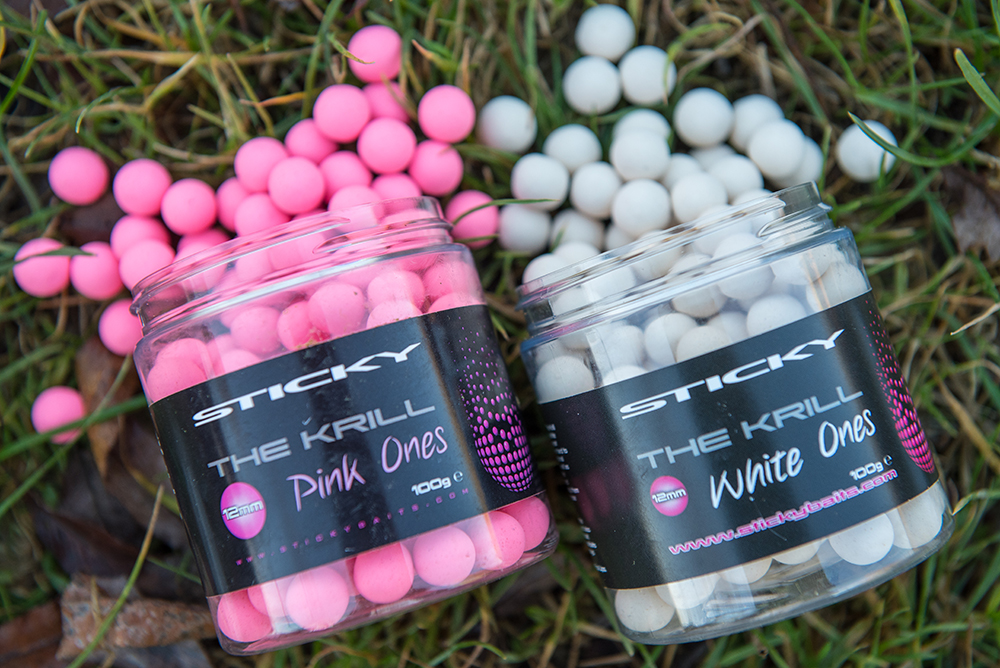
Snow Carp
I like periods when it snows heavily, I think a lot of very cold water going into the lake, which sinks pretty fast, is very favourable, particularly on deeper lakes. I feel like the fish will sink to the bottom and they’re much closer to your hook baits at all times then. Certainly in those conditions I’ve done well in the past, in big snow I catch and over the years it’s proved itself time and time again. Where they may have been up in the water before the shock of all the cold water going in shocks them and sends them down into the deeper water.
In general conditions where the carp are sitting low in the water but they simply won’t drop any further, it’s well worth fishing straight off the lead, suspending a pop-up 12 to 18 inches above the lakebed is a severely under-used tactic that again puts a lot of fish on the bank for me.

